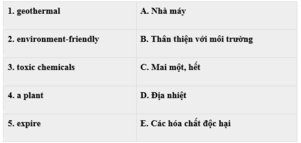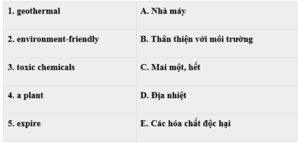Các câu hỏi tương tự
Hello students. Today Id like to tell you some information about types and sources of energy. Energy is classified into two main groups: renewable and non-renewable.The energy generated from natural sources such as the sun, wind, rain, and tides is called renewable energy. They are plentiful and can be generated again and again. They also have low carbon emissions so they are considered green and environment-friendly. Moreover, using renewable energy can reduce your electricity bills. Unfortunat...
Đọc tiếp
Hello students. Today I'd like to tell you some information about types and sources of energy. Energy is classified into two main groups: renewable and non-renewable.
The energy generated from natural sources such as the sun, wind, rain, and tides is called renewable energy. They are plentiful and can be generated again and again. They also have low carbon emissions so they are considered green and environment-friendly. Moreover, using renewable energy can reduce your electricity bills. Unfortunately, solar energy can be only used during the daytime but not during night or the rainy season. Geothermal energy also can bring toxic chemicals beneath the earth's surface to the top and can create environmental changes.
Non-renewable energy is the energy taken from other sources that are available on earth. They are limited and will run out in the future. They can't be re-generated in a short time. Fossil fuels - natural gas, oil and coal - are examples of them. They are cheap and easy to use. However, when burnt, they release toxic gases in the air so they cause serious environmental changes such as global warming. And the important thing is that non-renewable sources will expire someday.
Decide if the following statements are True or False or Not Given according to the text.
Question. The sun is one of the sources of energy which is friendly with the environment.
A. True
B. False
C. Not Given
Hello students. Today Id like to tell you some information about types and sources of energy. Energy is classified into two main groups: renewable and non-renewable.The energy generated from natural sources such as the sun, wind, rain, and tides is called renewable energy. They are plentiful and can be generated again and again. They also have low carbon emissions so they are considered green and environment-friendly. Moreover, using renewable energy can reduce your electricity bills. Unfortunat...
Đọc tiếp
Hello students. Today I'd like to tell you some information about types and sources of energy. Energy is classified into two main groups: renewable and non-renewable.
The energy generated from natural sources such as the sun, wind, rain, and tides is called renewable energy. They are plentiful and can be generated again and again. They also have low carbon emissions so they are considered green and environment-friendly. Moreover, using renewable energy can reduce your electricity bills. Unfortunately, solar energy can be only used during the daytime but not during night or the rainy season. Geothermal energy also can bring toxic chemicals beneath the earth's surface to the top and can create environmental changes.
Non-renewable energy is the energy taken from other sources that are available on earth. They are limited and will run out in the future. They can't be re-generated in a short time. Fossil fuels - natural gas, oil and coal - are examples of them. They are cheap and easy to use. However, when burnt, they release toxic gases in the air so they cause serious environmental changes such as global warming. And the important thing is that non-renewable sources will expire someday.
Question 3: The sun is one of the sources of energy which is friendly with the environment.
A. True
B. False
C. Not Given
Hello students. Today Id like to tell you some information about types and sources of energy. Energy is classified into two main groups: renewable and non-renewable.The energy generated from natural sources such as the sun, wind, rain, and tides is called renewable energy. They are plentiful and can be generated again and again. They also have low carbon emissions so they are considered green and environment-friendly. Moreover, using renewable energy can reduce your electricity bills. Unfortunat...
Đọc tiếp
Hello students. Today I'd like to tell you some information about types and sources of energy. Energy is classified into two main groups: renewable and non-renewable.
The energy generated from natural sources such as the sun, wind, rain, and tides is called renewable energy. They are plentiful and can be generated again and again. They also have low carbon emissions so they are considered green and environment-friendly. Moreover, using renewable energy can reduce your electricity bills. Unfortunately, solar energy can be only used during the daytime but not during night or the rainy season. Geothermal energy also can bring toxic chemicals beneath the earth's surface to the top and can create environmental changes.
Non-renewable energy is the energy taken from other sources that are available on earth. They are limited and will run out in the future. They can't be re-generated in a short time. Fossil fuels - natural gas, oil and coal - are examples of them. They are cheap and easy to use. However, when burnt, they release toxic gases in the air so they cause serious environmental changes such as global warming. And the important thing is that non-renewable sources will expire someday.
Match the words/ phrases with their corresponding meanings.

Question. Environment-friendly
Read the passage and complete the sentencesEnergy is fundament to human beings. Many poor people in developing countries do not have modern sources of energy like electricity or natural gas, with which their life can be improved. People who live in mountainous areas have to gather wood for fuel. This takes a lot of time. For many people living in rural areas, biogas is the largest energy resource available. The main use of biogas is for cooking and heating, but it can also provide energy for p...
Đọc tiếp
Read the passage and complete the sentences

Energy is fundament to human beings. Many poor people in developing countries do not have modern sources of energy like electricity or natural gas, with which their life can be improved.
People who live in mountainous areas have to gather wood for fuel. This takes a lot of time. For many people living in rural areas, biogas is the largest energy resource available. The main use of biogas is for cooking and heating, but it can also provide energy for public transport. As biogas is smoke-free, it helps the problem of indoor air pollution. Moreover, it is made from plant waste and animal manure. They cost almost nothing.
The tendency to use renewable energy sources in developing sources in developing countries is on the increase as non-renewable ones are running out. In the future, the wind and the sun will be uses as the most important environmentally friendly energy sources.
Question: In the future, the ________________________ will be used as the main environmentally friendly energy sources.
Hello students. Today Id like to tell you some information about types and sources of energy. Energy is classified into two main groups: renewable and non-renewable.The energy generated from natural sources such as the sun, wind, rain, and tides is called renewable energy. They are plentiful and can be generated again and again. They also have low carbon emissions so they are considered green and environment-friendly. Moreover, using renewable energy can reduce your electricity bills. Unfortunat...
Đọc tiếp
Hello students. Today I'd like to tell you some information about types and sources of energy. Energy is classified into two main groups: renewable and non-renewable.
The energy generated from natural sources such as the sun, wind, rain, and tides is called renewable energy. They are plentiful and can be generated again and again. They also have low carbon emissions so they are considered green and environment-friendly. Moreover, using renewable energy can reduce your electricity bills. Unfortunately, solar energy can be only used during the daytime but not during night or the rainy season. Geothermal energy also can bring toxic chemicals beneath the earth's surface to the top and can create environmental changes.
Non-renewable energy is the energy taken from other sources that are available on earth. They are limited and will run out in the future. They can't be re-generated in a short time. Fossil fuels - natural gas, oil and coal - are examples of them. They are cheap and easy to use. However, when burnt, they release toxic gases in the air so they cause serious environmental changes such as global warming. And the important thing is that non-renewable sources will expire someday.
Question 5: Non-renewable energy will run out in 150 years.
A. True
B. False
C. Not Given
Hello students. Today Id like to tell you some information about types and sources of energy. Energy is classified into two main groups: renewable and non-renewable.The energy generated from natural sources such as the sun, wind, rain, and tides is called renewable energy. They are plentiful and can be generated again and again. They also have low carbon emissions so they are considered green and environment-friendly. Moreover, using renewable energy can reduce your electricity bills. Unfortunat...
Đọc tiếp
Hello students. Today I'd like to tell you some information about types and sources of energy. Energy is classified into two main groups: renewable and non-renewable.
The energy generated from natural sources such as the sun, wind, rain, and tides is called renewable energy. They are plentiful and can be generated again and again. They also have low carbon emissions so they are considered green and environment-friendly. Moreover, using renewable energy can reduce your electricity bills. Unfortunately, solar energy can be only used during the daytime but not during night or the rainy season. Geothermal energy also can bring toxic chemicals beneath the earth's surface to the top and can create environmental changes.
Non-renewable energy is the energy taken from other sources that are available on earth. They are limited and will run out in the future. They can't be re-generated in a short time. Fossil fuels - natural gas, oil and coal - are examples of them. They are cheap and easy to use. However, when burnt, they release toxic gases in the air so they cause serious environmental changes such as global warming. And the important thing is that non-renewable sources will expire someday.
Question 2: There is a large amount of non-renewable energy.
A. True
B. False
C. Not Given
Hello students. Today Id like to tell you some information about types and sources of energy. Energy is classified into two main groups: renewable and non-renewable.The energy generated from natural sources such as the sun, wind, rain, and tides is called renewable energy. They are plentiful and can be generated again and again. They also have low carbon emissions so they are considered green and environment-friendly. Moreover, using renewable energy can reduce your electricity bills. Unfortunat...
Đọc tiếp
Hello students. Today I'd like to tell you some information about types and sources of energy. Energy is classified into two main groups: renewable and non-renewable.
The energy generated from natural sources such as the sun, wind, rain, and tides is called renewable energy. They are plentiful and can be generated again and again. They also have low carbon emissions so they are considered green and environment-friendly. Moreover, using renewable energy can reduce your electricity bills. Unfortunately, solar energy can be only used during the daytime but not during night or the rainy season. Geothermal energy also can bring toxic chemicals beneath the earth's surface to the top and can create environmental changes.
Non-renewable energy is the energy taken from other sources that are available on earth. They are limited and will run out in the future. They can't be re-generated in a short time. Fossil fuels - natural gas, oil and coal - are examples of them. They are cheap and easy to use. However, when burnt, they release toxic gases in the air so they cause serious environmental changes such as global warming. And the important thing is that non-renewable sources will expire someday.
Question 4: Non-renewable energy can be generated in a short time.
A. True
B. False
C. Not Given
Hello students. Today Id like to tell you some information about types and sources of energy. Energy is classified into two main groups: renewable and non-renewable.The energy generated from natural sources such as the sun, wind, rain, and tides is called renewable energy. They are plentiful and can be generated again and again. They also have low carbon emissions so they are considered green and environment-friendly. Moreover, using renewable energy can reduce your electricity bills. Unfortunat...
Đọc tiếp
Hello students. Today I'd like to tell you some information about types and sources of energy. Energy is classified into two main groups: renewable and non-renewable.
The energy generated from natural sources such as the sun, wind, rain, and tides is called renewable energy. They are plentiful and can be generated again and again. They also have low carbon emissions so they are considered green and environment-friendly. Moreover, using renewable energy can reduce your electricity bills. Unfortunately, solar energy can be only used during the daytime but not during night or the rainy season. Geothermal energy also can bring toxic chemicals beneath the earth's surface to the top and can create environmental changes.
Non-renewable energy is the energy taken from other sources that are available on earth. They are limited and will run out in the future. They can't be re-generated in a short time. Fossil fuels - natural gas, oil and coal - are examples of them. They are cheap and easy to use. However, when burnt, they release toxic gases in the air so they cause serious environmental changes such as global warming. And the important thing is that non-renewable sources will expire someday.
Question 1: This text may be written by a teacher.
A. True
B. False
C. Not Given
Hello students. Today Id like to tell you some information about types and sources of energy. Energy is classified into two main groups: renewable and non-renewable.The energy generated from natural sources such as the sun, wind, rain, and tides is called renewable energy. They are plentiful and can be generated again and again. They also have low carbon emissions so they are considered green and environment-friendly. Moreover, using renewable energy can reduce your electricity bills. Unfortunat...
Đọc tiếp
Hello students. Today I'd like to tell you some information about types and sources of energy. Energy is classified into two main groups: renewable and non-renewable.
The energy generated from natural sources such as the sun, wind, rain, and tides is called renewable energy. They are plentiful and can be generated again and again. They also have low carbon emissions so they are considered green and environment-friendly. Moreover, using renewable energy can reduce your electricity bills. Unfortunately, solar energy can be only used during the daytime but not during night or the rainy season. Geothermal energy also can bring toxic chemicals beneath the earth's surface to the top and can create environmental changes.
Non-renewable energy is the energy taken from other sources that are available on earth. They are limited and will run out in the future. They can't be re-generated in a short time. Fossil fuels - natural gas, oil and coal - are examples of them. They are cheap and easy to use. However, when burnt, they release toxic gases in the air so they cause serious environmental changes such as global warming. And the important thing is that non-renewable sources will expire someday.
Match the words/ phrases with their corresponding meanings.

Question. A plant
